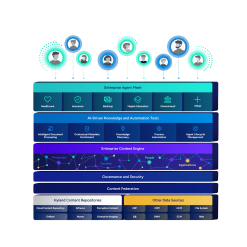Overcome unstructured inbox information with the Email Agent
With an ever-evolving and complex regulatory landscape, today’s organizations can leverage automation to gain more control over disparate information sent via email.

Harness the power of a unified content, process and application intelligence platform to unlock the value of enterprise content.
Learn more
Automate your document-centric processes with AI-powered document capture, separation, classification, extraction and enrichment.
Learn about Hyland IDPIt's your unique digital evolution … but you don't have to face it alone. We understand the landscape of your industry and the unique needs of the people you serve.
 Overview of industries
Overview of industries
Countless teams and departments have transformed the way they work in accounting, HR, legal and more with Hyland solutions.
 Overview of departments
Overview of departments
We are committed to helping you maximize your technology investment so you can best serve your customers.
 Overview of services
Overview of services

Discover why Hyland is trusted by thousands of organizations worldwide.
Hear from our customers
Our exclusive partner programs combine our strengths with yours to create better experiences through content services.
Overview of partners
Join The Shift newsletter for the latest strategies and expert tips from industry leaders. Discover actionable steps to stay innovative.
Register now
Hyland connects your content and systems so you can forge stronger connections with the people who matter most.
Learn about HylandWith our modern, open and cloud-native platforms, you can build strong connections and keep evolving.
 Dig deeper
Dig deeper
Email is the lifeblood of many organizations. It is a powerful tool for communicating, collaborating and getting things done.
Extensive use of email can cause information to be scattered throughout the organization. It can also lead to inefficient business processes with limited visibility into processes and difficulty properly managing important information.
With Hyland’s Perceptive Content Email Agent, you can gain more control over the disparate information being sent outside your core systems.
Advanced indexing capabilities improve information management and sophisticated audit features support compliance initiatives. Workflow features ensure important emails are included in the business process and easily accessible from within Perceptive Content.
In most organizations, vital business information is spread across multiple inboxes, resulting in information silos, tribal knowledge and the risk of losing valuable information.
Heavy reliance on email for driving business processes results in inconsistency, lack of control and visibility and redundant information and process steps.
Organizations can automatically capture email messages and attachments and import them directly into Perceptive Content Email Agent.
The Email Agent streamlines your business processes with the flexibility to assign email properties to index keys. It can also send out automatic replies and automatically forward captured emails to other email accounts.
Related articles
The Email Agent also gives you the flexibility to assign email properties (from, to, subject and simple email body searching) to index keys. It also provides the ability to exclude certain attachment types during import. Full-text search can be applied based on email body and attachment contents.
The capability to send automatic replies and automatically forward captured emails to other email accounts cuts down on administrative tasks and ensures information is sent to the right place. Emails and attachments can also be sent directly into business workflow processes based on email content, reducing manual work.
Perceptive Content Email Agent captures emailed document attachments, message body texts and delivers them to Perceptive Content.
A typical process flow looks like: